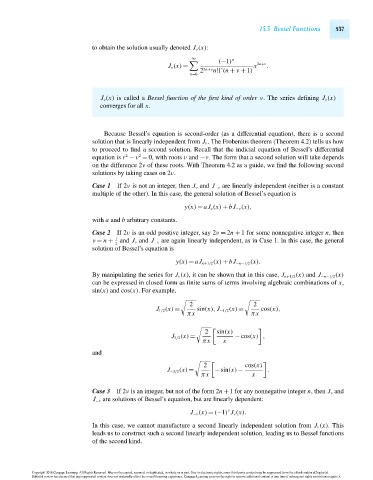Page 557 - Advanced_Engineering_Mathematics o'neil
P. 557
15.3 Bessel Functions 537
to obtain the solution usually denoted J ν (x):
∞ n
(−1)
J ν (x) = x 2n+ν .
2 2n+ν n!
(n + ν + 1)
n=0
J ν (x) is called a Bessel function of the first kind of order ν. The series defining J ν (x)
converges for all x.
Because Bessel’s equation is second-order (as a differential equation), there is a second
solution that is linearly independent from J ν . The Frobenius theorem (Theorem 4.2) tells us how
to proceed to find a second solution. Recall that the indicial equation of Bessel’s differential
2
2
equation is r − ν = 0, with roots ν and −ν. The form that a second solution will take depends
on the difference 2ν of these roots. With Theorem 4.2 as a guide, we find the following second
solutions by taking cases on 2ν.
Case 1 If 2ν is not an integer, then J ν and J −ν are linearly independent (neither is a constant
multiple of the other). In this case, the general solution of Bessel’s equation is
y(x) = aJ ν (x) + bJ −ν (x),
with a and b arbitrary constants.
Case 2 If 2ν is an odd positive integer, say 2ν = 2n + 1 for some nonnegative integer n, then
1
ν = n + and J ν and J −ν are again linearly independent, as in Case 1. In this case, the general
2
solution of Bessel’s equation is
y(x) = aJ n+1/2 (x) + bJ −n−1/2 (x).
By manipulating the series for J ν (x), it can be shown that in this case, J n+1/2 (x) and J −n−1/2 (x)
can be expressed in closed form as finite sums of terms involving algebraic combinations of x,
sin(x) and cos(x). For example,
2 2
J 1/2 (x) = sin(x), J −1/2 (x) = cos(x),
πx πx
2 sin(x)
J 3/2 (x) = − cos(x) ,
πx x
and
2 cos(x)
J −3/2 (x) = −sin(x) − .
πx x
Case 3 If 2ν is an integer, but not of the form 2n + 1 for any nonnegative integer n, then J ν and
J −ν are solutions of Bessel’s equation, but are linearly dependent:
ν
J −ν (x) = (−1) J ν (x).
In this case, we cannot manufacture a second linearly independent solution from J ν (x).This
leads us to construct such a second linearly independent solution, leading us to Bessel functions
of the second kind.
Copyright 2010 Cengage Learning. All Rights Reserved. May not be copied, scanned, or duplicated, in whole or in part. Due to electronic rights, some third party content may be suppressed from the eBook and/or eChapter(s).
Editorial review has deemed that any suppressed content does not materially affect the overall learning experience. Cengage Learning reserves the right to remove additional content at any time if subsequent rights restrictions require it.
October 14, 2010 15:20 THM/NEIL Page-537 27410_15_ch15_p505-562

